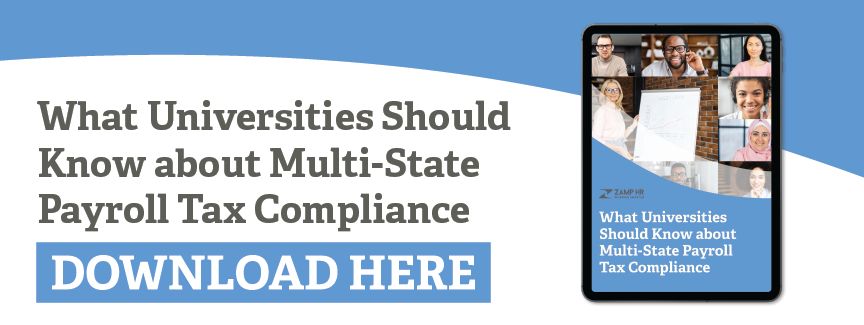According to a fourth-quarter 2020 survey, the majority (83%) of “knowledge workers” do not want to return to five days a week working in an office. This may mean university staff working full-time remotely. The new normal may encompass college faculty working in a flexible hybrid model. Both situations increase payroll complications when they lead to designating dual-state employees. HR staff know only too well how complex multi-state payroll processing is for colleges and universities.
HR payroll staff must deal with additional challenges when university staff lives and works in different states. That is true whether the dual-state employees are:
- Remote workers working entirely from home, or
- Faculty who travel to work from their home state to the university’s location in another state.
Happily, a singular solution exists to solve various payroll issues with dual-state employment issues.
5 Problems with Processing Multi-State Payroll
Five problems arise regarding multi-state payroll tax withholding.
Creating a New Tax Nexus
Each U.S. state has the right to impose tax burdens on businesses that have a tax nexus with the state. When a university has a business presence in a state, that presence creates a tax nexus with that state.
A university creates a presence within a state by:
- Maintaining a location and operations there,
- Staff and faculty working within a state while on university business, and
- Staff and faculty entering a state to perform work at the convenience of the employer.
Each state that enjoys a tax nexus with a university may require the university to withhold state income tax from staff and faculty. Universities and colleges withhold state income tax from staff and faculty wages for each state where the staff/faculty member performs work for the college or university.
For faculty or staff members who live in one state but work in another state, both states may impose the obligation to withhold state income taxes.
State-Specific Requirements
Most states try to avoid double taxation on their residents. Toward that end, various states have adopted regulations regarding residents who live in one state’s jurisdiction and work in another.
First, not all states have income tax withholding rules for their residents. The nine states without a state income tax include:
- Alaska
- Wyoming
- New Hampshire
- Washington State
- Nevada
- Tennessee
- Texas
- Florida, and
- South Dakota
Second, some states adopted reciprocity agreements. Under a reciprocity agreement, the states agree to withhold state income tax only for the resident’s home state. The District of Columbia and 16 other states have adopted at least one reciprocity agreement with another state.
Examples include:
- Maryland and the District of Columbia
- Virginia and the District of Columbia, and
- California and Arizona
Some states give their residents an income tax credit for the taxes paid to the nonresident state.
Other states have adopted either an income threshold or a number of days worked threshold before the nonresident’s employer must withhold income taxes for that state.
Keeping Up with Regulations
COVID-19 added a new wrinkle to the rules on income tax withholding. As thousands of workers began working remotely during the pandemic, some states provided that such workers did not create a nexus for the employer.
Those safe harbors appeared almost overnight in 2020 as the nation plunged into pandemic mode. Months later, states began revoking those safe harbors almost as quickly. For example, Pennsylvania lifted the safe harbor for remote workers as of July 1, 2021.
The swiftness with which states reacted to the COVID-19 pandemic is an excellent example of how quickly income tax rules and regulations can change. That creates an imperative for HR staff to keep up with the ever-evolving income tax withholding rules.
Having a multi-state payroll means HR staff must monitor the rules and regulations for every state where the university or college has faculty or a staff member.
How to Calculate Withholding
HR’s Income tax withholding duties become further complicated by the available withholding methods.
All Methodology
The “All Methodology” computes an individual’s taxes based on all income earned in the resident’s home state and all income earned in the nonresident state. Next, HR calculates the nonresident taxes based on the individual’s wages earned in the nonresident state(s). Then, HR reduces the resident’s taxes by the amount of the non-resident taxes.
This method creates a credit against the individual’s resident taxes. For example, New Jersey residents who work in New York State can claim a credit for taxes paid to New York State.
All with No Credit Methodology
This methodology is similar to the All Methodology concept, except that the resident state has tax credits to counter-balance the taxes paid to the nonresident state. The only state to use this methodology is Illinois.
However, Illinois income tax withholding rules depend on whether there are reciprocal agreements in place or voluntary withholding tax agreements. Illinois does not require income tax withholding for residents who solely perform work in another state if the nonresident state imposes income tax on the income.
Full Methodology
The Full Methodology calculation takes place in three steps. First, the resident state imposes the state’s income tax withholding on the wages earned in the resident state. Next, the wages earned in the nonresident state form the basis of income tax withholding under the resident state’s rules. Then, the two calculations combine into the total amount of state income tax withheld.
For example, Maryland uses the Full Methodology to compute the income tax withholding on residents who work in a non-reciprocal state. In this case, the university or college withholds income tax based on the non-reciprocal state’s wages using the non-reciprocal state’s rates.
Difference Methodology
The payroll tax withholding complications continue. Under this method, HR computes the income tax liability for the nonresident state based on the wages earned in that state. Then, HR calculates the income tax liability on the wages earned in the nonresident state but based on the resident state’s rate. Suppose the nonresident tax is less than the tax liability determined under the resident state’s rules using the nonresident wages. In that case, HR withholds the difference between the two tax liabilities as the resident state’s income tax withholding liability.
Indiana uses the Difference Methodology. Indiana requires businesses with a nexus to Indiana to withhold income tax for both the resident and nonresident states when an individual lives in one state and works in the nonresident state. In practice, however, the university or college would only withhold income tax for the amount that is the difference between the resident state and the nonresident state income tax withholding liability.
None Methodology
A few states do not apply any type of credit for nonresident taxes. Instead, they calculate the taxes for the faculty or staff’s resident and nonresident states based on the income earned in each jurisdiction. Alabama is one state that uses the None Methodology.
Apportionment
A business with nexus in several states must figure out how much business taxes it owes to each state. Companies that file tax returns in multiple states apportion their income between those states to avoid double taxation on the same income.
One way to do that is to divide profit into three categories:
- Where the business generates profit,
- Where the business owns property, and
- Where payroll happens.
As shown above, payroll is one factor that comes into play when apportioning a business’s income among multiple states. States also adopt various apportionment methods, which can complicate the apportionment calculation. HR staff must stay ahead of the game when it comes to rules and regulations that affect apportionment for each state affected by payroll.
Colleges and universities are usually exempt from business income taxes in the U.S. due to their tax-exempt status as educational institutions. However, that may not be the case for higher education institutions whose faculty or staff either travel between countries or who work remotely from another country. Business income apportionment may become an issue in such cases. Remote international faculty or staff members raise the specter of various payroll withholding laws and apportionment of business taxes.
Professional Employer Organizations as a Solution
One method businesses use to alleviate payroll duties is outsourcing payroll handling to a dedicated payroll processor. This does not assure compliance with multi-state payroll responsibilities.
Outsourcing payroll to a Professional Employer Organization (PEO) provides more comprehensive assistance in the form of an HR outsourcing partner. A PEO processes and files payroll taxes which shifts some legal responsibility to the PEO.
PEOs help colleges and universities determine whether it is advantageous to create a new tax nexus with another state. PEO staff monitor federal, state, local rules, and regulations. Your outsourcing HR partner determines income tax withholding and handles apportionment calculations for you. Perhaps best of all, hiring a PEO provides an average Return on Investment (ROI) of 27.2%.
Managing the complications from multi-state payroll and dual-state staff may stretch the resources of a university or college’s HR staff. The constant research and knowledge base required may burden small HR staff. Retaining the right PEO will free university and college staff to do what they do best: expand the growth of higher education.



